The Accidental Climber: Rocking Climbing for the Non-Athlete
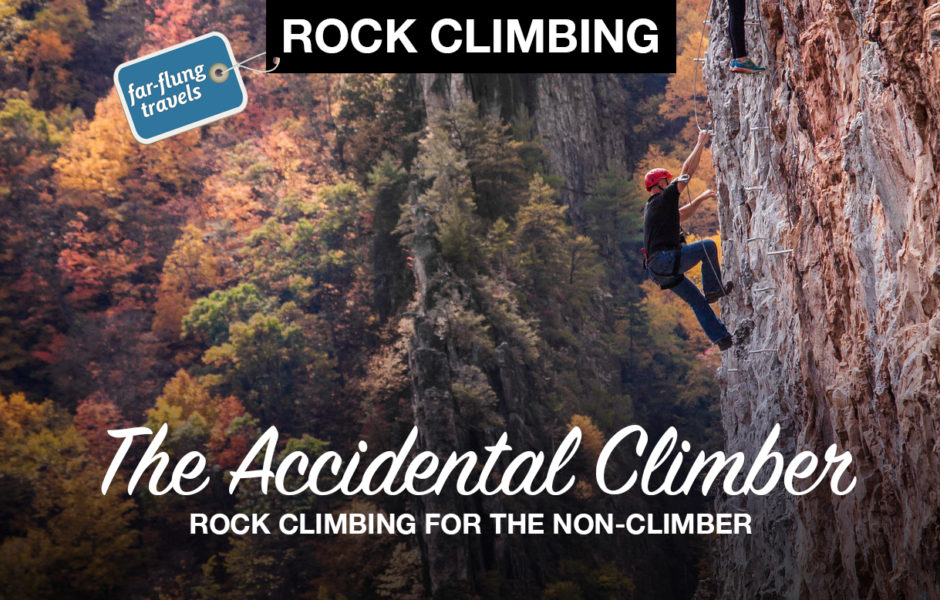
I’m a pretty good rock climber — at least I thought so until recently. I’ve climbed or rappelled in the Swiss Alps, the Rocky Mountains, Utah, New Mexico, Appalachia and the Blackhand sandstone cliffs in southern Ohio. I even managed to carry 50 pounds of gear and film portions of the documentary “Tripped Up” while clinging to a rock wall in Andermatt, Switzerland.
Then I came across a YouTube video of Austrian rock climber Angel Eiter. In the clip, she defies gravity as she dangles under a rock shelf from her fingertips. Her back and arm muscles ripple as she moves up the inverted rock and carefully places her toes on tiny footholds. I’m sure my mouth was agape as I watched her make the impossible look easy. I did a little digging and I found out Eiter became the first women in history to climb a 9b route in 2017, whatever that means. It sounds impressive, though.
Then it dawned on me that I’m not a good rock climber at all. I just happen to climb rocks on occasion. Furthermore, I’m not a hardcore super athlete; I don’t even recognize some of the muscles that Eiter has.
But there is good news. You don’t have to be in great shape to at least try out the sport of rock climbing. In fact, a Via Ferrata — like the one featured in “Tripped Up” — makes it easier for beginners because the climbing route is already established and it requires no technical skill. There are more than 50 through out Switzerland and many more throughout the world. The Via Ferrata Diavolo, for example, is a 1,500-foot vertical climb assisted by 2,500 feet of steel cable, ladders and 350 iron steps bolted into the rock face.
Here’s how it works: Once you’ve donned the proper safety equipment, you clip onto the steel cable with a Y-shaped lanyard attached to a climbing harness. The lanyard has two bungee-style arms with carabiners at the ends — one of which should always be on the cable. If you were to slip, you’d only fall 5 or 10 feet. Yes, it would hurt, but at least you wouldn’t die.
Now if that sounds too daunting, there are rock-climbing gyms that have instructors who will teach the basics. Then it’s up to you to take it as high or as far as you’d like. Ideally, you’d want to try it out in the real world, surrounded by nature.
There are great places to climb within a short drive of my hometown of Cleveland, especially the Hocking Hills and further south in West Virginia, where the terrain of Appalachia gets hillier and rockier.
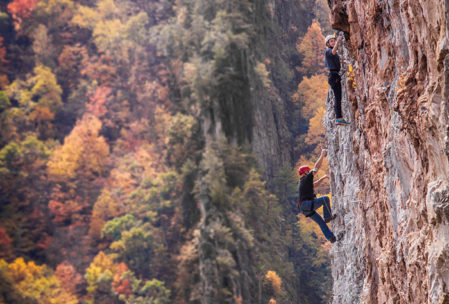
Climbing a Via Ferrata at NROCKS in West Virginia.
Now, if you haven’t been to central West Virginia, you’ll be blown away if you go. The scenery is absolutely idyllic, especially if you’re a rock climber. The crags and cracks of the sandstone cliffs in the area are perfect for rock climbing and there are more than 1,400 established rock-climbing routes along the Gauley and New rivers. Many climbs require technical skill, but there are plenty of places for novices to give the sport a try with an experienced guide. White-water outfitter and resort Adventures on the Gorge, for example, offers a multi-sport boat trip on Summersville Lake, which is surrounded by cliffs only accessible by boat.
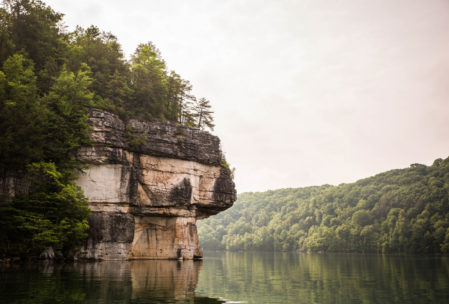
Adventures on the Gorge offers a multi-sport boat trip on Summersville Lake, which includes basic rock climbing on the cliffs.
So, it was on that tour that I found myself staring into a crevice buzzing with wasps.Here’s a photo of a yellow jacket that will help you get into the moment with me:

Everyone in my group was told to avoid using that particular spot for a handhold. Several climbers before me had safely climbed up, over and around that hellhole. So when it was my turn to ascend, I grabbed on and started climbing up the rock face with the guide belaying me from the back of the boat. It was all good.
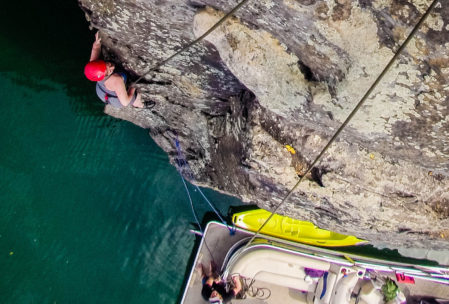
Climbing at Summersville Lake.
I got about 40 feet up (although it felt like 200 feet) and I came face to face with those wasps. And even though I didn’t touch their nest at all, they were right there. My hands were already above that spot feeling around for another hold, but my face was in the line of fire.
I started imagining getting stung all over my face and how much it was going to really, really hurt. Then, I’d let go and my brain would bash into the rocks below and plummet into the lake and die a second death by drowning.
And that’s when it happened (not the death part). One of those angry little bastards zoomed out of the crevice and zipped past my face.
“Phew!”
I remember thinking I had dodged a bullet.
A few moments later, it doubled back and like a kamikaze pilot, rammed into my shoulder at full speed and torpedoed my tender flesh with its damn stinger.
In that instant, my first instinct was to scream and let go. But our brains work in mysterious, amazing ways. Mine starting having a whole conversation by itself and perhaps with a few of my emotions chiming in, too.
While I consider myself an optimist overall, anger, fear, disgust and sadness had taken over the conversation, which went something like this:
Disgust: “Ow.”
Anger: “Son of a bitch.”
Sadness: “That hurts. I think we’re going to cry.”
Fear: “We’re going to die if we fall off this cliff.”
Sadness: “I’ll be really sad if we die.”
Optimism: “Just let go! The guide is spotting us.”
Fear: “Sure, he’s holding the rope, but is he really paying attention. I can’t see if he’s paying attention.”
Optimism: “Trust him. He knows what he is doing. He’s been doing this awhile. At least all summer.”
Fear: “Wait, it’s only Memorial Day Weekend … And how old is this kid? He looks like he’s about 10. He probably gets distracted easily.”
Disgust: “Look at all the other people on the boat. Maybe they are all joking around right now and he’s forgetting that we’re up here.”
Optimism: “I’m sure once he feels the tug on the rope, he’ll react quickly and be able to catch us.”
Disgust: “But he’s so scrawny. He certainly can’t hold our weight.”
Anger: “Hey guys, this is starting to hurt worse and I think it’s swelling up. We gotta do something here. Let’s not waste any more time.”
Optimism: “Okay, maybe we can warn him before we let go.”
All: “Um, okay.”
This entire internal conversation took place in just a split second before I finally said something like: “Um, hey guys, I just got stung. I’m coming down. Are you holding onto the rope?”
All my emotions gasped in shock at how calmly I managed to keep my shit 💩 together.
The guide responded with “On belay!” That essentially means he’s paying attention and he’s ready for me to let go.
I released my death grip and he lowered me safely to the boat and I think someone had some anti-itch cream that I slathered on the wound. It hurt for a few days, but that’s about it.
That excursion wasn’t a complete waste; nor has it stopped me from rock climbing, at least my more-relaxed version of it. I discovered my first Via Ferrata a year after this incident took place and I’ve done two others since, including one in West Virginia at a place called NROCKS. I love seeking out new adventures and new places to explore and when an opportunity comes my way, I seize the moment. I am not afraid of trying new things. Most recently, I stopped by High Rock Adventures in Logan, Ohio, to try out their climbing and rappelling options.
That day on Summersville Lake was one of those times I tried something new. While I didn’t climb again that day, the boat was stocked with stand-up paddleboards (SUPs) and a kayak. I hopped on a stand-up paddleboard for the first time in my life and spent the rest of the time splashing around at the surface of the lake instead of on the rocks. I was shaken, not stirred.
Let’s drink to that.
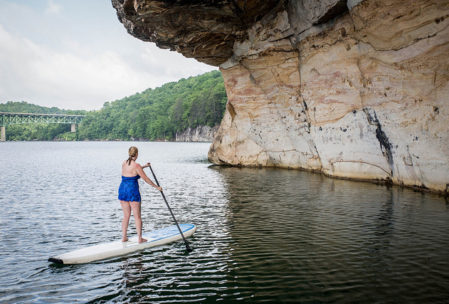
Stand-up paddleboarding at Summersville Lake.
___________________
This story is adapted from a tale I told to a group of outdoor enthusiasts during Play Days, a free weekend of events in Cleveland sponsored by REI, in April 2018. For more information about telling stories in bars, check out Story Club Cleveland.

Write a Reply or Comment